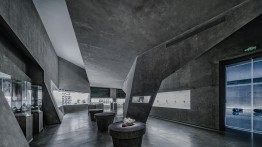COOPERMADE: Building a Narrative

The firm Atelier Alter Architects creates buildings that frequently look like weighty, oversized crystals suspended in air. No wonder the Yingliang Group, a mining and stone products company, commissioned the practice co-founded by Cooper graduate Yingfan Zhang AR’06 to design the Yingliang Stone Natural History Museum in Xiamen, China. The museum was designed to house a collection of precious stones from around the world, explain the role of stones and minerals in human civilization, and act as a research center for historians, archeologists, and geologists.
Zhang, who with her partner Xiaojun Bu founded Atelier Alter Architects in 2009, explores seeming opposites in her architectural designs: dynamism and permanence, mass and weightlessness. The museum is housed in an extant office building, which posed some challenges for a design that would support the varied programs of the space and visually convey the institution’s focus, i.e., the history of stone. Zhang and Bu decided to create a frame that fit into the existing building’s structure that inserted a new perimeter wall around the ground floor and divided exhibition spaces into sharply angular rooms, mimicking the shape of crystals. The original building had been fitted with a large skylight that the firm kept in place but underneath that feature, which they refer to as “the pergola,” they built a set of angled light monitors to control the direction of light in the exhibition spaces. They added a series of walls set at acute angles from each other that, seen in plan, create a diagonal channel cutting across the building. Inside, the exhibition halls are covered with artistic concrete paint, a charcoal gray to create a cool, cavernous atmosphere for the stones on display.
In a 2020 article with ArchDaily, Zhang, who earned her Master of Architecture in Urban Design from Harvard's GSD, described her approach to architecture as one directly influenced by her Cooper education: “We are very optimistic,” she said, “and we look for ideas everywhere, particularly Chinese history, art, and landscape. A found object could suggest a certain aspect of our architecture. Architecture sparked by an instrument, pottery, or a story, is very appealing and natural to me. These ideas are coming from my mentor and professors at [The] Cooper Union – Raimund Abraham and Diane Lewis, as well as studying the works of such architects as Peter Eisenman, Lebbeus Wood and Daniel Libeskind."





